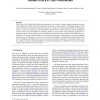Free Online Productivity Tools
i2Speak
i2Symbol
i2OCR
iTex2Img
iWeb2Print
iWeb2Shot
i2Type
iPdf2Split
iPdf2Merge
i2Bopomofo
i2Arabic
i2Style
i2Image
i2PDF
iLatex2Rtf
Sci2ools
EGH
2010
Springer
2010
Springer
Parallel SAH k-D tree construction
The k-D tree is a well-studied acceleration data structure for ray tracing. It is used to organize primitives in a scene to allow efficient execution of intersection operations between rays and the primitives. The highest quality k-D tree can be obtained using greedy cost optimization based on a surface area heuristc (SAH). While the high quality enables very fast ray tracing times, a key drawback is that the k-D tree construction time remains prohibitively expensive. This cost is unreasonable for rendering dynamic scenes for future visual computing applications on emerging multicore systems. Much work has therefore been focused on faster parallel k-D tree construction performance at the expense of approximating or ignoring SAH computation, which produces k-D trees that degrade rendering time. In this paper, we present two new parallel algorithms for building precise SAH-optimized k-D trees, with different tradeoffs between the total work done and parallel scalability. The algorithms ...
| Added | 10 Feb 2011 |
| Updated | 10 Feb 2011 |
| Type | Journal |
| Year | 2010 |
| Where | EGH |
| Authors | Byn Choi, Rakesh Komuravelli, Victor Lu, Hyojin Sung, Robert L. Bocchino Jr., Sarita V. Adve, John C. Hart |
Comments (0)

